Seattle Public Schools officials want to close seven schools by next fall and use the savings to close the district'ês budget gap, but using budget problems to make policy changes that will affect neighborhoods for years to come is a dumb way to raise money. And a really dumb way to make policy.
The District pleads necessity — the need to close a 2009-10 budget gap predicted at $24 million with worst-case scenarios (state-level cuts) taking it past $40 million. That doesn'êt make the proposal any smarter. And the money saved, estimated by Seattle School District officials at $2.1 million to $4.2 million per year for seven elementary-sized school buildings on the discard list, isn'êt much — particularly at the low end of the range — compared to the disruption (and possible enrollment loss) of closing schools and moving school programs from place to place like so many houses and hotels on a Monopoly board. Here's the list of closures and program shifts.
One good sign from a Tuesday night school board work session on the proposals, put forward by Superintendent Maria Goodloe-Johnson, was the apparent skepticism of school board members during the four-hour discussion. The plan is not likely to be approved as proposed, though it'ês too early to tell which school communities have the voice to influence the plan and what exactly will change. Meanwhile, there'ês a clutch of reasons why the whole plan should be delayed until the school board deals with other policy decisions that should come before school closure decisions.
The assignment plan. Changes in the student assignment plan were delayed when Goodloe-Johnson arrived two years ago so she could put her mark on the new system. Enough waiting. Time for the board to step up. What Seattle needs is an assignment plan based on where families with children actually live, a neighborhood-schools plan where students are assigned to the closest school and required to go there — with some options for alternative schools and kids from low-income families to move around. Until this is done, you don'êt rationally know which schools to close. And considering falling housing prices, wouldn'êt it be smart to expect kids to return to the south end and Central Area where enrollment has fallen lately?
Cut busing. A neighborhood-based assignment plan, as above, would cut busing costs, saving about as many dollars predicted for the superintendent'ês school-closure plan. In fact, some of the program changes in the plan (moving APP from a closed Lowell, moving Summit all the way to the Rainier Beach High School Building) may increase busing costs.
Bilingual education. The district is developing a new way to deliver bilingual education, and this program should be completed before buildings are closed or programs are moved. The system Seattle uses now to help newcomers learn English is about the most expensive imaginable. It'ês heavy on staff and it relies on bilingual instructional aides scattered across the district, to help kids in a variety of languages. More centralized, intensive instruction to raise English language learners to a higher level before sending them out to regular schools could save significant labor cost — and fill a school building or two. Closing schools now may preclude some bilingual program options.
Stop confounding capital and operating budgets. Goodloe-Johnson'ês plan has the condition of buildings as a primary criterion, arguing that closing them would save capital expenditures later on. But since the mid 1990s the district has had a clear, ongoing program of capital-funded major maintenance. New buildings abound and overall building condition is up since then. Capital maintenance is voter-funded and can be used to do the work on buildings the district decides to operate because they'êre the best for neighborhood cohesion and school programs. In other words, where buildings are located is always more important to educational programs than building condition. Nor does the capital saving of closing a building that needs maintenance help close the current expense educational programs budget gap.
Here are two other thoughts about the new proposal. First, the plans put on the table Tuesday night did not include creation of any more K-8 schools. The decision to move Summit and put a K-8 in the Addams building was made earlier in the month. Since K-8s are practically parents'ê favorite thing, any school closure plan should create more K-8s, say at Meany, a good-sized building now a middle school. In the Superintendent'ês plan Meany is wasted as the new home for two programs that don'êt really need to move there.
The plan also in a way signals the end of Seattle'ês alternative school movement, or at least the failed options among those in the experiment, and that'ês probably good. The Goodloe-Johnson plan kills outright AS #1, and the African American Academy, mostly for poor academic achievement, and moves Summit from the far north to the far south — a thinly disguised poison pill. The board should also take note of the successes in this 30-year experiment: TOPS and Salmon Bay, both K-8s, and NOVA and the Center School, both notably small high schools. These programs are not cookie crumbs dropped on the trail supposed to lead us out of the woods. These are big, lighted highway signs.


